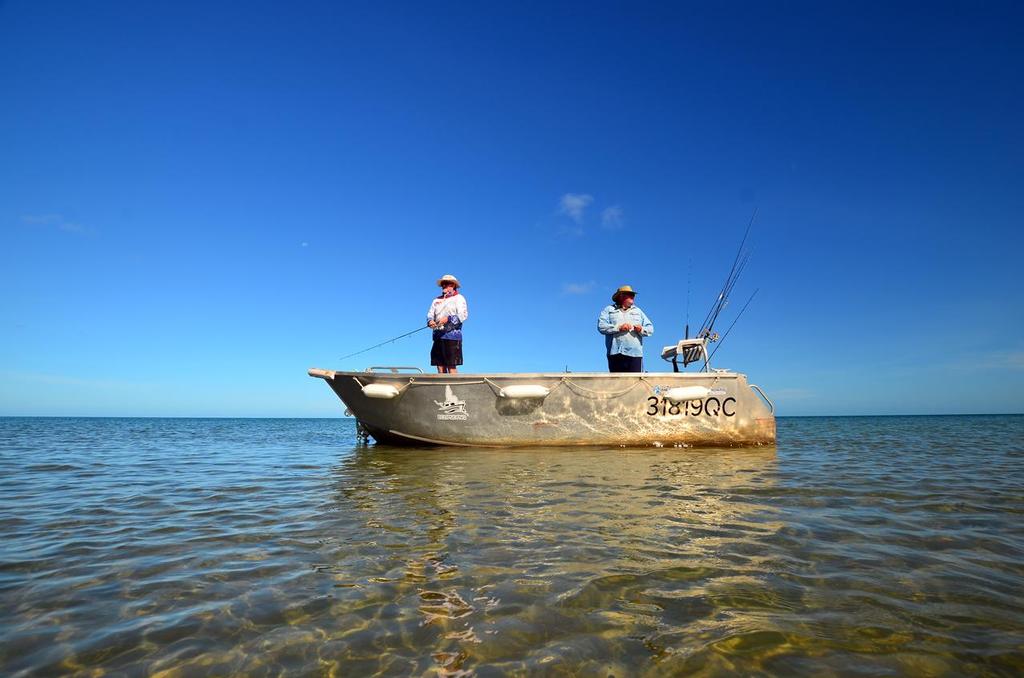Tactics of the Tip 4- How shallow is too shallow?
by Lee Brake on 29 Apr 2013

Graham Brake (L) and Dave "Lumpy" Milson (R) fishing the sandy flats in less than a metre of water. This was an awesome session of sight-casting to pelagics. Lee Brake
In the fourth and final part of his series recounting some of the lessons leant while fishing with Eclipse FNQ Charters in Cape York's remote rivers, Lee Brake has a look at a personal misconception relating to shallow water.
I've always thought that fish liked deep water. After all, don't we as anglers constantly search our depth sounders for steep banks and deep holes which we believe will hold the motherload of piscatorial predators? I personally have often looked at a bank and dismissed it with a grimace and the words 'Nah, there's not enough water there to hold fish'.
After my week at the Tip with the crew of Eclipse, I've come to realise that I may have been rather misguided...
It all started in the Doughboy River just after half way through the trip. Bruce Riddle, Neil Drogemuller (Droggy) and I decided to fish a superb looking deep bank near the mouth. In these shallow rivers where a 'deep' channel is two metres, this bank was a standout at over six metres deep right near the river mouth. We did everything; we trolled, cast, vibed, cranked and jigged it, but other than a few small trevally, we drew a blank. It was then that we got the call from Lumpy on the radio who, along with my old man, was fishing the draining sandflats that fringed the Doughboy's mouth. 'Grab your fly rods and come out here,' he strongly suggested. We obliged and headed out into less than a metre of water where you could see the bottom clearly, and as soon as the sun came out you could see the bottom for a casting distance in every direction. And it was alive!
Queenfish, golden trevally, mackerel and giant herring were all moving through these shallow, sandy waters – it was all rather picturesque. For the next hour we had a ball on all manner of species until a giant groper decided to join in on the adventure. One big queenfish snack later and it had succeeded in driving us off in search of other, easier targets, but the life on those shallow flats had really surprised me.
This shallow water success was further amplified when later that afternoon, the three of us decided to begin our assault on drains. We'd been fishing drains with surface lures with great success (see part three - http://www.fishingboating-world.com/Tactics-of-the-Tip-III:-Doggin-Cape-York-barra-+-Video/108678) and knew that we needed one that was 'working'. Unfortunately the Doughboy was rather shallow and the first one we found with obvious water running out had all of 40cm of water at its mouth. We decided to give it a quick hit anyway when we saw two barra 'boof' at its mouth in quick succession.
Well, we were hooked-up within seconds of casting and we continued to catch barra one after another until the depth sounder actually stopped reading (at less than 30cm). Even then though, the barra were still sitting in the small channel carved by the drain and would smack almost every lure worked through it. It was truly amazing!
But the shallow water shenanigans don't stop there. At the Skardon River the next day we were sitting up on the Eclipse's poop deck enjoying a beverage while watching some fish absolutely annihilate bait right up against the nearby bank. Eventually, Bruce and I couldn't contain ourselves any longer and jumped in a tender and headed over. We beached the boat and walked the bank with our fly rods. The action was instantaneous. Barra and queenfish were literally killing bait less than a metre from our toes – which were on dry land! I lost count of the queenies I caught by simply rolling a rod-length of line straight out and stripping fast backwards, and Bruce had a barra from one of his first casts and followed that up with a bream, of all things! Once again, the water would have been 30cm deep at the most, yet the bait was there and the fish were using the shallow water to trap them. I even managed a nice jack that carved the water before slamming my fly – it was whoop-worthy stuff!
So there you have it folks, shallow water doesn't mean fish-less water. In fact, it can be completely the opposite. Obviously, spooking the fish can become an issue and you don't want to get stuck on a falling tide, but that doesn't mean that you shouldn't fish it. Look for drains and gutters flowing off shallow flats and put long casts at them from a distance – it's a great way to find fish.
That folks, is my last article on my techniques leant at the Tip. I hope you've enjoyed them as much as I did leaning them. If you're ever planning a trip north to Cape York for some fishing, make sure you check out Eclipse FNQ Charters (http://www.eclipsefnq.com.au/). It's a comfortable, roomy boat with a great crew and the food is to die for! Look them up!
If you want to link to this article then please use this URL: www.sail-world.com/108958